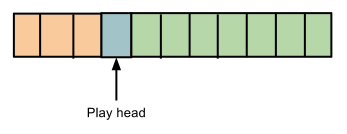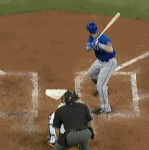Experimental version feedback needed ! 
Beware of regressions and report anything suspicious. Do not assume the issue is known.
Installer: [s]Kinovea.Setup.0.8.17[/s], See Kinovea.Setup.0.8.18 instead.
So what's new ?
A. Playback performances
Reading performances has been the number one effort of this iteration. It has led to some wide and deep refactoring to the internal pipeline.
I don't want to go too far into the details because they are probably boring, but there are a few things you might be interested in to make the most of it.
I'm not going to post benchmarks either, please test with your files and report.
1. Asynchronous decoding with prebuffering.
- It is a third mechanism to pull the frames from the files into Kinovea. (the others being "one frame at a time", and the "cache" or "analysis" mode).
- It is enabled automatically anytime relevant.
- Conceptually, the buffer looks like this:

During continuous reading, the play-head is always kept roughly at this position. The buffer anticipates some frames ahead of the position (green blocks) and it keeps a few after it.
The result is smoother reading and support for immediate back stepping (up to a few frames).
It runs in its own thread so the decoding can be done in parallel to the rendering.
2. Unscaled rendering.
- It's not hardware accelerated graphics, but it's the closest thing I know of in GDI+ land.
- The idea is to decode the images at the size we will render them, so that we can render them without interpolation.
- It may seem obvious, but it has far reaching implications, considering image stretching feature, zooming, magnifier tool, mirroring, trajectory tool and coordinates, dual screen superposition, etc.
- The important point is: the smaller the image, the smoother it will play.
- To provide more control, it is now possible to manually squeeze the image smaller than its original size. So if a file is jerky, try to reduce the rendering rectangle a bit.
B. But also
- Danish locale ! (Heinrich Winther).
- Animated GIF. Yes, you read that right baseball mechanics addicts 
- Images files are now treated differently. They are turned into 10-second videos. (So you can add several sheets of drawings on it). Duration will be configurable later on.
Killed bugs : 257, 258, 269.
+ Raw changelog.
Almost every area of the application have been impacted somehow. So please report regressions ASAP, thanks.


